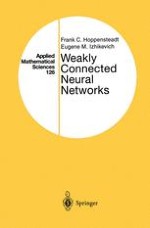1997 | OriginalPaper | Buchkapitel
Local Analysis of WCNNs
verfasst von : Frank C. Hoppensteadt, Eugene M. Izhikevich
Erschienen in: Weakly Connected Neural Networks
Verlag: Springer New York
Enthalten in: Professional Book Archive
Aktivieren Sie unsere intelligente Suche, um passende Fachinhalte oder Patente zu finden.
Wählen Sie Textabschnitte aus um mit Künstlicher Intelligenz passenden Patente zu finden. powered by
Markieren Sie Textabschnitte, um KI-gestützt weitere passende Inhalte zu finden. powered by
The local activity of a weakly connected neural network (WCNN) is described by the dynamical system (5.1)$$ \dot X_i = F_i \left( {X_i ,\lambda } \right) + \varepsilon G_i \left( {X_1 , \ldots ,X_n ,\lambda ,\rho ,\varepsilon } \right),{\text{ i = 1,}} \ldots {\text{,n,}} $$ where Xi ∈ ℝm, λ ∈ Λ, and ρ ∈ R, near an equilibrium point. First we use the Hartman-Grobman theorem to show that the network’s local activity is not interesting from the neurocomputational point of view unless the equilibrium corresponds to a bifurcation point. In biological terms such neurons are said to be near a threshold. Then we use the center manifold theorem to prove the fundamental theorem of WCNN theory, which says that neurons should be close to thresholds in order to participate nontrivially in brain dynamics. Using center manifold reduction we can substantially reduce the dimension of the network. After that, we apply suitable changes of variables, rescaling or averaging, to simplify further the WCNN. All these reductions yield simple dynamical systems that are canonical models according to the definition given in Chapter 4. The models depend on the type of bifurcation encountered. In this chapter we derive canonical models for multiple saddle-node, cusp, pitchfork, Andronov-Hopf, and BogdanovTakens bifurcations. Other bifurcations and critical regimes are considered in subsequent chapters, and we analyze canonical models in the third part of the book.
